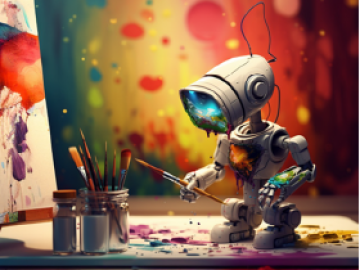In recent years, a new force has emerged that promises to redefine the boundaries of machine capability: generative AI.
At its core, generative AI is a subset of machine learning models designed to generate novel data, be it in the form of images, music, or text, that is almost, if not entirely, indistinguishable from those created by humans. Its significance in the AI realm cannot be understated, as it not only showcases what machines can achieve but also challenges our traditional notions of creativity.
As we gain experience with this transformative technology, one can't help but wonder: Where will the line between human and artificial creativity be drawn as it continues to be increasingly blurred?
The Mechanics Behind Generative AI
Generative AI operates at the intersection of advanced algorithms and intricate data patterns. At its foundation lies the concept of neural networks, inspired by the human brain's structure.
These networks consist of layers of interconnected nodes or "neurons" that process and transmit information. As data flows through these layers, the network learns to recognize patterns and make predictions or generate new data based on its training.
Not long ago, the primary role of machine learning was in the realm of forecasting models, designed to detect and categorize trends within data. Consider the typical task of discerning recurring objects or themes within a photo or among a set of photos.
However, generative AI elevates this capability exponentially. Instead of merely recognizing and categorizing an object, advanced machine learning can now generate a visual or textual representation of an object when prompted. Not only that, but it can create entire worlds filled with contextually rich descriptions and imagery based on both simple and complex prompts.
The central reason for this leap is that new machine-learning models are trained on extremely large and varied sets of unstructured data1. And, because the amount of data used to train these algorithms is so massive, the models can appear "creative" when producing outputs2.
But what is creativity…really?
Creativity—once considered the exclusive domain of human intuition and inspiration—is not as elusive and magical as we often make it out to be. Creative thinking consists largely of intentionally combining patterns, ideas, and concepts to produce unique creations. So, what we perceive as innovative or novel ideas are essentially a recombination or reinterpretation of existing thoughts and concepts.
This idea—that new ideas are just combinations of old ideas—is a concept often attributed to Mark Twain. He famously stated, "There is no such thing as a new idea. We simply take a lot of old ideas and put them into a sort of mental kaleidoscope."
Similarly, in "Where Good Ideas Come From: The Natural History of Innovation," Steven Johnson discusses the concept of the "adjacent possible," suggesting that innovative ideas often arise from the combination of existing ideas or patterns3.
So it’s not surprising that generative AI is disrupting the world of creativity with its unique ability to access its vast reservoir of data to generate not only novel outputs but also to produce them at scales no human can match.
Creative Applications of Generative AI
As we’ve explored above, Generative AI is carving a niche for itself in the heart of creativity. This, of course, includes the world of artistic expression. From the strokes of a painter's brush to the rhythm of a musician's chord and the depth of a writer's prose, we are now having to rethink how we perceive and produce art.
Below are some notable applications that showcase the artistic power of generative AI.
- Art Creation: Platforms like Midjourney and AI models such as DALL-E empower users to produce distinctive artworks that appear as if crafted by human artists.
- Music Composition: OpenAI's MuseNet can compose songs in various styles, from classical to contemporary.
- Fashion Design: Designers are now using GenAI to create innovative fashion designs, pushing the boundaries of style and imagination.
- Video Game Environments: Game developers employ GenAI to create expansive and intricate virtual worlds, enhancing the gaming experience by offering players ever-changing and unpredictable landscapes.
- Literary Works: Tools like ChatGPT have been used to craft poems, short stories, film scripts, and even entire novels.
- Dance Choreography: AI systems are being trained to generate new choreography by analyzing countless dance moves, offering a blend of traditional and avant-garde sequences.
- Digital Art Installations: Artists are collaborating with AI to create dynamic digital installations. These pieces evolve in real time, responding to environmental factors or audience interactions, resulting in a unique blend of art and technology.
- Culinary Innovations: In the culinary arts, chefs are using GenAI to come up with novel recipes, flavor combinations, and presentation styles.
Generative AI in Business and Industry
Not surprisingly, the influence of Generative AI extends far beyond the confines of artistic endeavors. Its transformative potential is being harnessed across industries, reshaping traditional business models, decision-making processes, and innovation strategies.
It’s also making other significant creative and performance contributions by streamlining everything from interiors to product packaging and allowing businesses to address varied consumer tastes effortlessly. It even crafts tailored campaigns that resonate with specific audiences, boosting engagement and ROI.
Additionally, generative tools are revolutionizing the creation of sustainable and efficient designs by simulating diverse scenarios. Industries like manufacturing, are tapping into AI's potential for process optimization and predictive maintenance.
For leaders, especially those at the helm of creative sectors, this presents both challenges and opportunities, with impacts on:
The Role of Leadership
With tools that can generate designs, advertisements, or even product concepts, leaders must recalibrate their value propositions. The emphasis shifts from creation to curation, guidance, and the integration of AI outputs with human insights. Leaders are now tasked with blending the best of both worlds to deliver unparalleled value.
Insight Generation and Decision-Making
Data-driven insights are the cornerstone of modern decision-making. Generative AI takes this a step further by not just analyzing existing data but generating potential scenarios. This predictive modeling can help businesses anticipate market shifts, consumer preferences, or potential risks, enabling proactive rather than reactive strategies.
Innovation and Growth
Innovation is no longer restricted to brainstorming sessions or R&D labs. With generative AI, companies can more rapidly generate and prototype new ideas, test new concepts, and explore untapped markets. This accelerates the innovation cycle, drives growth, and offers a competitive edge in a rapidly evolving marketplace.
Investing in AI
Initially, there might have been reservations about the extent of enthusiasm warranted for generative AI tools, particularly for leaders and businesses balancing the costs of tech adoption against anticipated returns. Yet, its transformative potential was swiftly acknowledged by many.
Underscoring the widespread acknowledgment of its potential, VCs steadily increased their positions in generative AI, from $408 million in 2018 to $4.5 billion in 2024 and ChatGPT garnered one million users within just five days of its public launch5.
Not surprisingly, AI is changing the game across industries, ensuring that businesses remain competitive and agile. In terms of economic growth, a recent study6 found that companies investing more in AI technology had higher growth rates from 2010 to 2018.
As the technology matures, its cost-effectiveness and scalability make it an indispensable asset. Forward-thinking organizations would be wise to not only integrate AI tools into their operations but also invest in research, collaborations, and training to fully harness its potential. But, for many businesses at the forefront of the new AI movement, investing in generative AI is not just about staying relevant; it's about envisioning and ushering in the future.
The Ethical Implications of Generative AI
As with any groundbreaking technology, the rise of generative AI brings with it a slew of ethical considerations. While its potential to revolutionize industries is undeniable, it also introduces challenges that society must address to ensure its responsible and beneficial use.
One of the most alarming applications of generative AI is the creation of deepfakes. These are hyper-realistic but entirely fake pieces of content, be it manipulated videos of public figures or fabricated audio recordings. The implications of such technology for spreading misinformation and manipulation are profound and far-reaching.
Alongside this, as AI begins to produce art, music, and literature, complex questions arise about ownership and rights. Determining who owns an AI-generated piece—whether it's the developer, the user, or perhaps no one at all—becomes a pressing concern.
Furthermore, with an influx of AI-generated content in the market, there's an inherent risk of diluting genuine human creativity. As the distinction between human-made and AI-generated content becomes increasingly blurred, society grapples with challenges related to authenticity and the intrinsic value of creative works.
Strategies for Responsibly Managing and Using Generative AI
- Transparency: It's crucial for creators to disclose the use of AI in their work. Whether it's a piece of art, a news article, or a product design, audiences have a right to know the origins of what they're consuming.
- Regulation: Governments and regulatory bodies need to establish clear guidelines and laws around the use of generative AI, especially in areas like deepfakes, to prevent misuse.
- Education: As generative AI becomes more mainstream, educating the public about its capabilities and limitations is essential. This will empower individuals to critically assess AI-generated content and make informed decisions.
- Ethical AI Design: Developers and companies should prioritize ethical considerations in the design and deployment of generative AI tools. This includes building systems that are fair, transparent, and free from biases.
- In essence, while generative AI offers immense potential, it's imperative to navigate its growth with caution, foresight, and a deep commitment to ethical principles.
The Future of Generative AI
As we stand on the cusp of a new era in artificial intelligence, the future of generative AI holds promise and intrigue. Experts in the field predict a trajectory of rapid advancements, with the technology evolving in ways we can only begin to imagine.
It's crucial to consider the full spectrum of AI's potential impacts. This sentiment is echoed in recent initiatives, such as the executive order signed by Governor Gavin Newsom on 9/6/23, which establishes collaborations between California agencies, UC Berkeley, and Stanford University to examine the effects of generative AI on the state and its workforce.7
Predictions about Future Developments and Advancements in Generative AI
Breakthroughs in generative artificial intelligence have the potential to bring about sweeping changes to the global economy, according to Goldman Sachs Research. As tools using advances in natural language processing work their way into businesses and society, they could drive a 7% (or almost $7 trillion) increase in global GDP and lift productivity growth by 1.5 percentage points over a 10-year period.8
Beyond economic impacts, generative AI is poised to become deeply ingrained in our daily routines, integrating seamlessly across various devices and systems with tools that not only produce and curate content but also adapt to human emotions and offer real-time personalized experiences.
As this technology evolves, we might imagine the emergence of AI collaborators—entities that partner with humans in creative endeavors, grasping subtleties and providing innovative insights.
Final Thoughts on the Transformative Potential of GAI
Generative AI is not a mere technological trend; it's a paradigm shift. And, as it permeates business, industry, and our private lives, it will continue to challenge our concepts of human insight, creativity, and even thought leadership.
However, in the words of a recent Marketing Profs piece, “Effective thought leadership provides more than information. It provides the reader with introspection and personal experiences—true stories of success, failure, and ingenuity under pressure. AI can't create that”.9
Indeed, while generative AI offers unparalleled capabilities, it is the human spirit, with its rich tapestry of emotions and experiences, that breathes life into creativity and cultivates true wisdom. By harnessing the power of GenAI as a tool rather than a replacement, we can amplify our imaginations, forging a future where technology and humanity work as one to reshape our world and revolutionize experiences toward a more common good.
References
- What every CEO should know about generative AI
- What is generative AI?
- Johnson, S. (2010). Where good ideas come from: The natural history of innovation. Riverhead Books.
- VCs continue to pour dollars into generative AI - TechCruch
- Exploring opportunities in the generative AI value chain
- Investing in AI boosts firm growth—and increases market dominance, study finds - Berkeley Haas News
- https://data.berkeley.edu/news/california-agencies-uc-berkeley-stanford-study-generative-ai-impacts
- Generative AI could raise global GDP by 7% - Goldman Sachs
- Are You There, ChatGPT? It's Me, Marketing. - Marketing Profs
Dive Deeper
Take a deep-dive into this topic and gain expert, working knowledge by joining us for the program that inspired it!
Artificial Intelligence: Business Strategies and Applications
Learn about AI’s current capabilities and potential, the reach of automation, machine learning, and robotics.
View details on partner site


